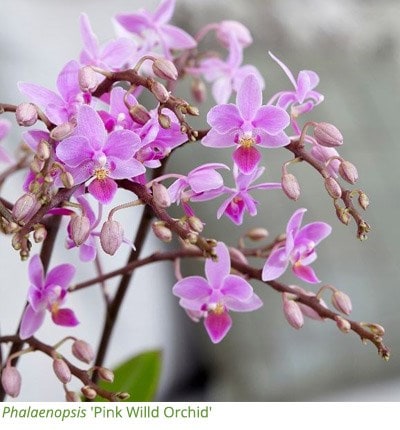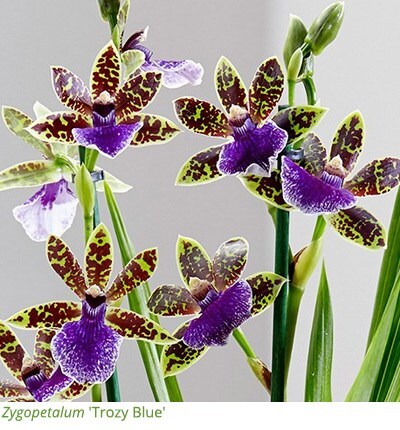British winters can be bleak, so even the keenest of gardeners tends to garden vicariously inside the house. Fresh flowers are few and far between so it's a wonderful thing to have an exotic orchid flowering in the depths of winter, because it will flower for many weeks bringing summer a step closer.
Which Orchids to buy
 These days orchids are affordable, as ‘cheap as chips’ as Jamie Oliver would say, and no longer a rich man's preserve. We can all acquire an orchid at a very reasonable price because these days they're raised by tissue culture. The process involves a milky looking growing media, with the correct mycorrhizal fungus added. Pieces of plant material are placed into glass flasks and these swirl around and produce the perfect orchid. These days orchids are affordable, as ‘cheap as chips’ as Jamie Oliver would say, and no longer a rich man's preserve. We can all acquire an orchid at a very reasonable price because these days they're raised by tissue culture. The process involves a milky looking growing media, with the correct mycorrhizal fungus added. Pieces of plant material are placed into glass flasks and these swirl around and produce the perfect orchid.
The moth orchid, or Phalaenopsis, is now ubiquitous and it's the easiest starting point because these upright orchids, with elegant arching stems, cope with central heating really well. The large, rounded, six-petalled flowers come in a variety of pallid colours and the flower’s shape does resemble a moth, hence the name. Good light levels are needed in winter to promote flower buds, but not full sun. The recommended positions are either an east-facing or west-facing windowsill.
How to look after an Orchid
An average daytime temperature between 19 - 25C is ideal for moth orchids, although night-time temperatures can go a little lower. It's best to remove any orchid from the windowsill in cold weather because temperatures behind the curtains or blinds may plummet below their preferred 16C. Most new flowering stems are produced in November and December, because flower bud production is prompted by lower daytime temperatures. The flowers appear in March and you may get 4 to 5 months of flower power, so they're extremely good value. Once the flowers have finished cut back to the second node on the stem – the bumpy bit. This is also the best time to repot your orchid, every couple of years, using an orchid compost. You can also remove any faded leaves at this point.
Watering is important and most orchids are grown in clear plastic pots because the plant grows better if the roots develop in light, bright conditions. The colour of the roots is an indicator of how much water they need at that point. If the roots are white, the plant is dry, and the pot will feel light. The best way to water it is to let a gentle flow of water run through the pot for 20 to 30 seconds. Tap water doesn't seem to affect moth orchids. Once the plant is rehydrated the roots will change colour and become soft green. Try not to splash the leaves when watering and water more sparingly in winter. Never let any orchid sit in water because most are high altitude plants used to getting misted in tropical jungles. Use an atomiser to recreate this situation. If it’s really dry stand it in a bowl of water for 10 minutes, but then let it drain.
Where to plant Orchids
Moth orchids develop aerial roots as well, although these will rot if you try to cover them in compost. If they shrivel away to nothing, just trim them back but leave most of them intact. Orchids also need feeding with a proprietary orchid food because this is far weaker than standard pot plant food.
What type of Orchids are there?
 Some of the most desirable orchids have tidier foliage and smaller flowers in richer colours and Phalaenopsis grandiflorum 'Rio Grande' has more branches per stem. The dainty 'Pink Willd Orchid' (yes that really is how you spell it!), has almost viola shaped flowers in shades of pink. There are also blush-white and pure white versions of this multi-stemmed ‘Willd’ orchid. Or, if you're a chocoholic, opt for ‘Chocolate Drops’ one of the darkest of the moth orchids. One thing though, it’s said that the whites and pale pinks flower for longer. The choice is yours! Some of the most desirable orchids have tidier foliage and smaller flowers in richer colours and Phalaenopsis grandiflorum 'Rio Grande' has more branches per stem. The dainty 'Pink Willd Orchid' (yes that really is how you spell it!), has almost viola shaped flowers in shades of pink. There are also blush-white and pure white versions of this multi-stemmed ‘Willd’ orchid. Or, if you're a chocoholic, opt for ‘Chocolate Drops’ one of the darkest of the moth orchids. One thing though, it’s said that the whites and pale pinks flower for longer. The choice is yours!
If you want an orchid for a north-facing windowsill, the strappy foliage and pansy-like flowers of the Miltonia will be perfect. They’re more compact and often come in rich reds and pinks and their flowers are fragrant although not as long lasting. These shade lovers peak during the summer, and ‘Sunset’ comes in a summery combination of lime-yellow and purplish pink. In their native land, and most are bred from a Brazilian species, they are used to a daily drenching, so water often and let them drain.
Miltoniopsis 'Herr Alexander', a pure white with a cherry and yellow middle splash, is another summer blooming orchid although it will sometimes produce a later flush in autumn. Miltonia and Miltoniopsis do best grown close to other orchids and house plants, rather than in isolation. They also like warmth. Oncidiums are less fussy about temperature. They are sometimes known as Dancing lady orchids because the lower two petals resemble a flamenco skirt and the upper ones two arms ruffed in lace. They like some sun, so find them a bright spot, and when they're in full growth and flower they will need watering every other day. Oncidium 'Katarina Zoch' has very dainty sprays of flower in a combination of red and pink, relieved by the yellow eye.
 Zygopetalum 'Trozy Blue’ has fragrant, waxy looking flowers in bright blue, plum-purple and zingy lime-green. The long linear leaves frame the flowers. These enjoy moderate temperatures, rather than heat, and they like to be moist rather than soggy. Find ‘Trozy Blue’ a bright space on an east or west-facing windowsill so that it gets diffused light rather than strong midday sun. Careful watering is the key to keeping this orchid happy. Zygopetalum 'Trozy Blue’ has fragrant, waxy looking flowers in bright blue, plum-purple and zingy lime-green. The long linear leaves frame the flowers. These enjoy moderate temperatures, rather than heat, and they like to be moist rather than soggy. Find ‘Trozy Blue’ a bright space on an east or west-facing windowsill so that it gets diffused light rather than strong midday sun. Careful watering is the key to keeping this orchid happy.
× Oncidopsis 'Nelly Isler' is a more difficult prospect because it enjoys high humidity and lower temperatures that don’t rise above 24C/ 75F. Keep it constantly moist, because it will hate drying out, and keep it an airy position. Standing this in a tray of wet pebbles will help. This hybrid is highly desirable because it has red flowers, although with a soft touch of apricot.
If you want something easier, with claret-red and white tipped flowers, opt for Cambria 'Lazio', a hybrid involving Miltonia, Odontoglossum, Oncidium and other orchid genera. Partial shade, reasonable but diffused light, temperate warmth and regular watering will keep the exotic looking ‘Lazio’ happy. When the weather bites, you can gaze at your tropical orchid and think of warmer times and far flung places.
|






 Zygopetalum 'Trozy Blue
Zygopetalum 'Trozy Blue




